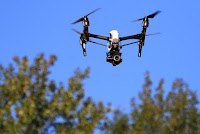DJI Inspire 1 Pro X5 Reviews
One year ago, June of 2016, I purchased DJI's Inspire 1 Pro X5 system from AerialMediaPros.com. I bought a kit that included 4 batteries and a second remote for the camera operator. A custom pelican case was also part of the kit. I also bought two nVidia Shield tablets to use as monitors.It has worked well, overall. I'm more than disappointed with the camera image quality. I'll get into that in another post.
After 1 year and hundreds of flights later I'm now publishing some feedback. One of my recently published aerials shows Melrose Wakefield Hospital in Melrose Massachusetts.
My Aerial Photography Background:
DJI Flamewheel F550
In Sept of 2012 I built DJI's F550 flamewheel hex and rigged it up with a GoPro and and FPV camera. The limitations of the lightweight GoPro Hero 2 prompted me to explore a different camera option.
When I learned the F550 would fly a Sony NEX 6, I made a custom camera bracket and that set up was miles ahead of the GoPro. Due to the weight of the NEX 6, I had to fly with no gimbal. Correcting tilted horizons all the time... however image quality was vastly superior to the GoPro. I had no video feed. Got the shots I wanted using an interval app in the NEX and pointing the drone in the direction I wanted photographed.
DJI Phantom Vision II v3
Yada Yada Yada. Everybody's familiar with the Phantoms. Mine is the model just before the distortion reduction lens was introduced. I still have it but rarely use it. I'd like to sell it. The portability of the Mavic is appealing.
Now for the DJI Inspire 1 Pro X5 Review!
First flight with the new Inspire brought no surprises. It is very responsive on the horizontal axis. Because of is substantial mass, it does not climb as quickly as a Phantom. However it descends much faster than a Phantom II.
With the default settings, if she's moving horizontally quickly and you let go of the stick, it stops abruptly. A bit too abruptly. I've learned to ease off the stick flying the Inspire to avoid those hard stops. The previous drones I've piloted glide to a smooth stop upon stick release.
The aircraft itself is robust and rigid. The landing gear should auto-raise after take of but that does not always occur on my rig. most of the time I leave the gear down. That's because most of the time I've got the Olympus 45MM lens on the X5. Its narrow field of view (90MM equivalent)
Altitude hold could be better, mine drifts up and down as much as 10' especially if it's windy.
It should be noted that I fly cautiously. I never fly beyond line of sight. After almost 1 year of use... I've had NO CRASHES, not even a hard landing. I do much more still photography than filming so much of the time it's just parked in the sky.
I've decided to make a separate post for the DJI X5 camera and that will follow soon.
AIRFRAME PROS:
The Inspire 1 Pro X5 is heavy, and that makes it more stable, than lighter drones, in high winds. It should be noted that all drones loose some controllability in high winds. When winds are more than 20 MPH movement into the wind can be very sluggish. Battery drain happens faster in windy conditions.
The Inspire 1 Pro X5 is heavy, and that makes it more stable, than lighter drones, in high winds. It should be noted that all drones loose some controllability in high winds. When winds are more than 20 MPH movement into the wind can be very sluggish. Battery drain happens faster in windy conditions.
Horizontal position hold is excellent. Ability to descend smoothly for landing is never a problem, even in windy conditions. Vertical position hold drifts more than I like but that's only problematic when attempting to hover close to the ground.
AIRFRAME CONS:
Lately I've been getting screen freezes on the DJI GO app. Not sure why. I changed my USB cord and some of the video frequency setting...it seems to have helped.
As mentioned earlier, my copy does not alway raise gear automatically after take off I often take off from soft grass. I believe the down facing ultrasonic sensor, which seems to trigger auto-gear-raising, work better over hard surfaces.
Since DJI batteries are part of the DJI Inspire 1 airframe, here's my gripe with the batteries. You'll get warnings on the DJI GO app indicating the batteries should be drained below 5% occasionally to maintain them. However, running them down that low in flight will always trigger a RTH (return to home) or it will auto land itself. There's no easy way to discharge these DJI Inspire batteries!
Overall I'm happy with the DJI Inspire 1 Pro X5 airframe and gimbal. That camera image quality is another story... and that story will come in a separate blog post. Thanks for listening!
If you need New England area roof inspections by drone visit my Web site or give me a call at 781-244-5655
If you need New England area roof inspections by drone visit my Web site or give me a call at 781-244-5655





